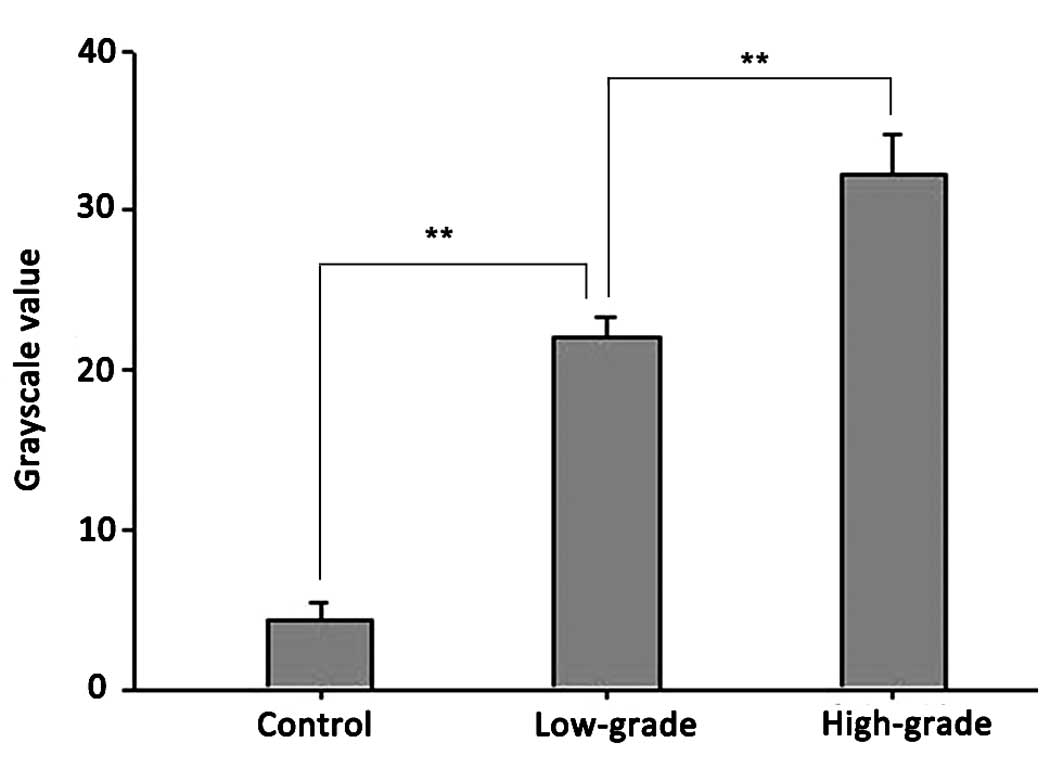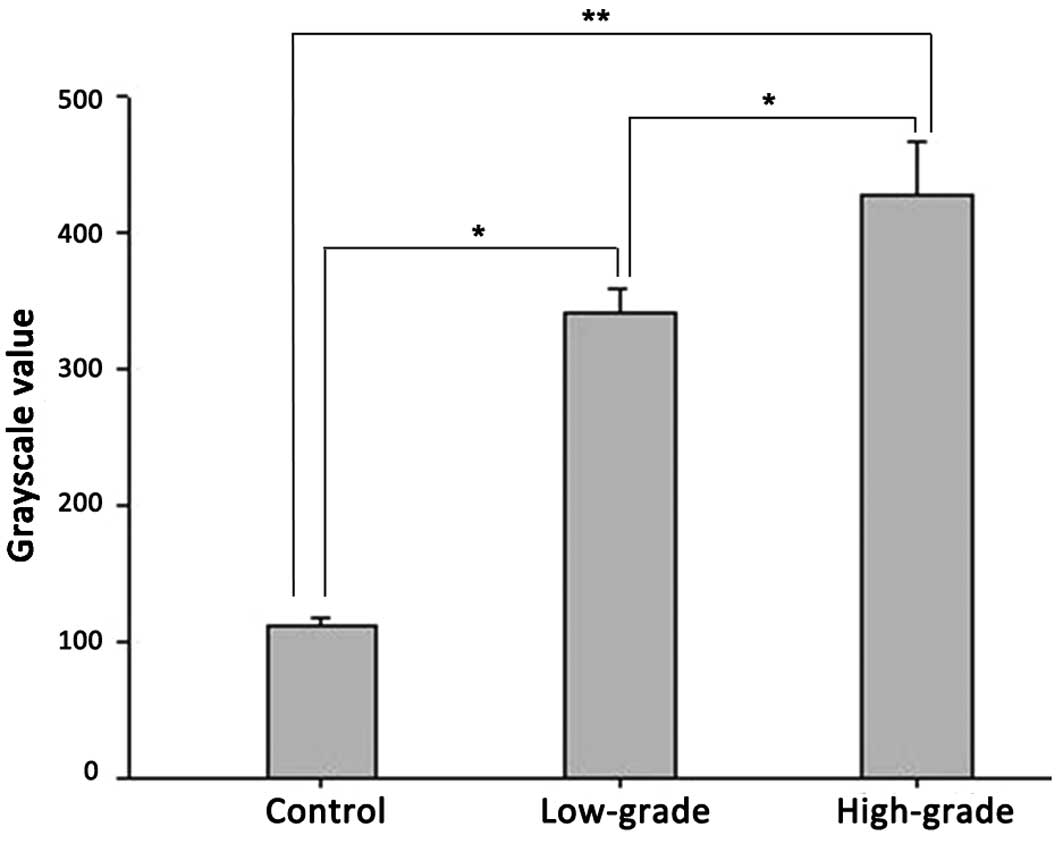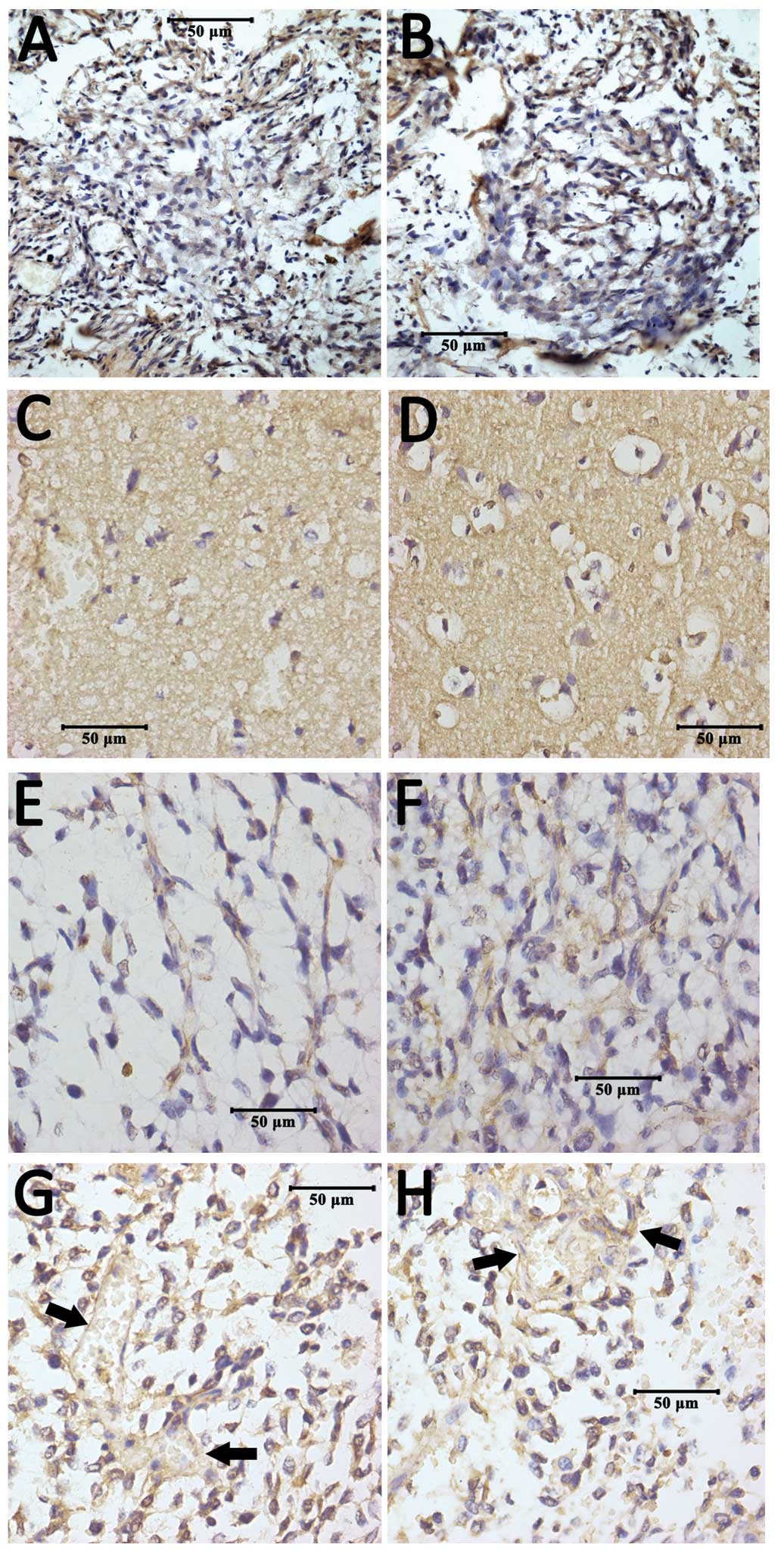|
1
|
Ohgaki H and Kleihues P: Epidemiology and
etiology of gliomas. Acta Neuropathol. 109:93–108. 2005. View Article : Google Scholar : PubMed/NCBI
|
|
2
|
Stupp R, Mason WP, van den Bent MJ, et al:
European Organisation for Research and Treatment of Cancer Brain
Tumor and Radiotherapy Groups; National Cancer Institute of Canada
Clinical Trials Group: Radiotherapy plus concomitant and adjuvant
temozolomide for glioblastoma. N Engl J Med. 352:987–996. 2005.
View Article : Google Scholar : PubMed/NCBI
|
|
3
|
Qiu B, Zhang D, Wang Y, et al:
Interleukin-6 is overexpressed and augments invasiveness of human
glioma stem cells in vitro. Clin Exp Metastasis. 30:1009–1018.
2013. View Article : Google Scholar : PubMed/NCBI
|
|
4
|
Qiu B, Zhang D, Tao J, Tie X, Wu A and
Wang Y: Human brain glioma stem cells are more invasive than their
differentiated progeny cells in vitro. J Clin Neurosci. 19:130–134.
2012. View Article : Google Scholar : PubMed/NCBI
|
|
5
|
Stylli SS, Howes M, MacGregor L, Rajendra
P and Kaye AH: Photodynamic therapy of brain tumours: evaluation of
porphyrin uptake versus clinical outcome. J Clin Neurosci.
11:584–596. 2004. View Article : Google Scholar : PubMed/NCBI
|
|
6
|
Stylli SS, Kaye AH, MacGregor L, Howes M
and Rajendra P: Photodynamic therapy of high grade glioma - long
term survival. J Clin Neurosci. 12:389–398. 2005. View Article : Google Scholar : PubMed/NCBI
|
|
7
|
Park DM and Rich JN: Biology of glioma
cancer stem cells. Mol Cells. 28:7–12. 2009. View Article : Google Scholar : PubMed/NCBI
|
|
8
|
Cuddapah VA, Robel S, Watkins S and
Sontheimer H: A neurocentric perspective on glioma invasion. Nat
Rev Neurosci. 15:455–465. 2014. View
Article : Google Scholar : PubMed/NCBI
|
|
9
|
Coniglio SJ and Segall JE: Review:
molecular mechanism of microglia stimulated glioblastoma invasion.
Matrix Biol. 32:372–380. 2013. View Article : Google Scholar : PubMed/NCBI
|
|
10
|
Kaczarek E, Zapf S, Bouterfa H, Tonn JC,
Westphal M and Giese A: Dissecting glioma invasion: interrelation
of adhesion, migration and intercellular contacts determine the
invasive phenotype. Int J Dev Neurosci. 17:625–641. 1999.
View Article : Google Scholar : PubMed/NCBI
|
|
11
|
Stamenkovic I: Extracellular matrix
remodelling: the role of matrix metalloproteinases. J Pathol.
200:448–464. 2003. View Article : Google Scholar : PubMed/NCBI
|
|
12
|
Bulstrode H, Jones LM, Siney EJ, et al:
A-Disintegrin and Metalloprotease (ADAM) 10 and 17 promote
self-renewal of brain tumor sphere forming cells. Cancer Lett.
326:79–87. 2012. View Article : Google Scholar : PubMed/NCBI
|
|
13
|
Edwards DR, Handsley MM and Pennington CJ:
The ADAM metalloproteinases. Mol Aspects Med. 29:258–289. 2008.
View Article : Google Scholar : PubMed/NCBI
|
|
14
|
Pruessmeyer J and Ludwig A: The good, the
bad and the ugly substrates for ADAM10 and ADAM17 in brain
pathology, inflammation and cancer. Semin Cell Dev Biol.
20:164–174. 2009. View Article : Google Scholar : PubMed/NCBI
|
|
15
|
Huovila AP, Turner AJ, Pelto-Huikko M,
Kӓrkkӓinen I and Ortiz RM: Shedding light on ADAM
metalloproteinases. Trends Biochem Sci. 30:413–422. 2005.
View Article : Google Scholar : PubMed/NCBI
|
|
16
|
Seals DF and Courtneidge SA: The ADAMs
family of metalloproteases: multidomain proteins with multiple
functions. Genes Dev. 17:7–30. 2003. View Article : Google Scholar : PubMed/NCBI
|
|
17
|
Zhao R, Ni D, Tian Y, Ni B and Wang A:
Aberrant ADAM10 expression correlates with osteosarcoma
progression. Eur J Med Res. 19:92014. View Article : Google Scholar : PubMed/NCBI
|
|
18
|
Armanious H, Gelebart P, Anand M, Belch A
and Lai R: Constitutive activation of metalloproteinase ADAM10 in
mantle cell lymphoma promotes cell growth and activates the
TNFα/NFκB pathway. Blood. 117:6237–6246. 2011. View Article : Google Scholar : PubMed/NCBI
|
|
19
|
Zhang W, Liu S, Liu K, et al: A
disintegrin and metalloprotease (ADAM)10 is highly expressed in
hepatocellular carcinoma and is associated with tumour progression.
J Int Med Res. 42:611–618. 2014. View Article : Google Scholar : PubMed/NCBI
|
|
20
|
Ko SY, Lin SC, Wong YK, Liu CJ, Chang KW
and Liu TY: Increase of disintergin metalloprotease 10 (ADAM10)
expression in oral squamous cell carcinoma. Cancer Lett. 245:33–43.
2007. View Article : Google Scholar : PubMed/NCBI
|
|
21
|
Kleihues P, Louis DN, Scheithauer BW, et
al: The WHO classification of tumors of the nervous system. J
Neuropathol Exp Neurol. 61:215–229. 2002.PubMed/NCBI
|
|
22
|
Qiu B, Li X, Sun X, et al: Overexpression
of aquaporin-1 aggravates hippocampal damage in mouse traumatic
brain injury models. Mol Med Rep. 9:916–922. 2014.PubMed/NCBI
|
|
23
|
Qiu B, Sun X, Zhang D, Wang Y, Tao J and
Ou S: TRAIL and paclitaxel synergize to kill U87 cells and
U87-derived stem-like cells in vitro. Int J Mol Sci. 13:9142–9156.
2012. View Article : Google Scholar : PubMed/NCBI
|
|
24
|
Wolfsberg TG and White JM: ADAMs in
fertilization and development. Dev Biol. 180:389–401. 1996.
View Article : Google Scholar : PubMed/NCBI
|
|
25
|
Yoshimura T, Tomita T, Dixon MF, Axon AT,
Robinson PA and Crabtree JE: ADAMs (a disintegrin and
metalloproteinase) messenger RNA expression in Helicobacter
pylori-infected, normal, and neoplastic gastric mucosa. J Infect
Dis. 185:332–340. 2002. View
Article : Google Scholar : PubMed/NCBI
|
|
26
|
Rocks N, Paulissen G, El Hour M, et al:
Emerging roles of ADAM and ADAMTS metalloproteinases in cancer.
Biochimie. 90:369–379. 2008. View Article : Google Scholar : PubMed/NCBI
|
|
27
|
Wildeboer D, Naus S, Amy Sang QX, Bartsch
JW and Pagenstecher A: Metalloproteinase disintegrins ADAM8 and
ADAM19 are highly regulated in human primary brain tumors and their
expression levels and activities are associated with invasiveness.
J Neuropathol Exp Neurol. 65:516–527. 2006. View Article : Google Scholar : PubMed/NCBI
|
|
28
|
Kodama T, Ikeda E, Okada A, et al: ADAM12
is selectively overexpressed in human glioblastomas and is
associated with glioblastoma cell proliferation and shedding of
heparin-binding epidermal growth factor. Am J Pathol.
165:1743–1753. 2004. View Article : Google Scholar : PubMed/NCBI
|
|
29
|
D'Abaco GM, Ng K, Paradiso L, Godde NJ,
Kaye A and Novak U: ADAM22, expressed in normal brain but not in
high-grade gliomas, inhibits cellular proliferation via the
disintegrin domain. Neurosurgery. 58:179–186. 2006. View Article : Google Scholar : PubMed/NCBI
|
|
30
|
Zheng X, Jiang F, Katakowski M, et al:
Inhibition of ADAM17 reduces hypoxia-induced brain tumor cell
invasiveness. Cancer Sci. 98:674–684. 2007. View Article : Google Scholar : PubMed/NCBI
|
|
31
|
McCulloch DR, Akl P, Samaratunga H,
Herington AC and Odorico DM: Expression of the disintegrin
metalloprotease, ADAM-10, in prostate cancer and its regulation by
dihydrotestosterone, insulin-like growth factor I, and epidermal
growth factor in the prostate cancer cell model LNCaP. Clin Cancer
Res. 10:314–323. 2004. View Article : Google Scholar : PubMed/NCBI
|
|
32
|
Schulz B, Pruessmeyer J, Maretzky T, et
al: ADAM10 regulates endothelial permeability and T-Cell
transmigration by proteolysis of vascular endothelial cadherin.
Circ Res. 102:1192–1201. 2008. View Article : Google Scholar : PubMed/NCBI
|
|
33
|
Millichip MI, Dallas DJ, Wu E, Dale S and
McKie N: The metallo-disintegrin ADAM10 (MADM) from bovine kidney
has type IV collagenase activity in vitro. Biochem Biophys Res
Commun. 245:594–598. 1998. View Article : Google Scholar : PubMed/NCBI
|
|
34
|
Kohutek ZA, diPierro CG, Redpath GT and
Hussaini IM: ADAM-10-mediated N-cadherin cleavage is protein kinase
C-alpha dependent and promotes glioblastoma cell migration. J
Neurosci. 29:4605–4615. 2009. View Article : Google Scholar : PubMed/NCBI
|
|
35
|
Yang CL, Jiang FQ, Xu F and Jiang GX:
ADAM10 overexpression confers resistance to doxorubicin-induced
apoptosis in hepatocellular carcinoma. Tumour Biol. 33:1535–1541.
2012. View Article : Google Scholar : PubMed/NCBI
|



















